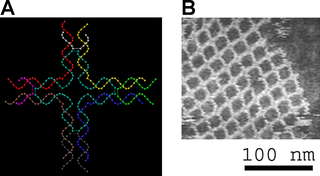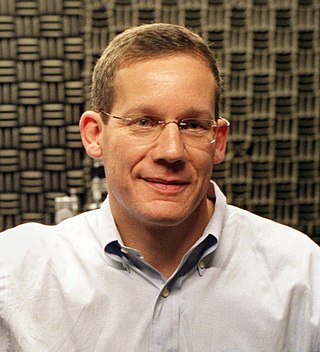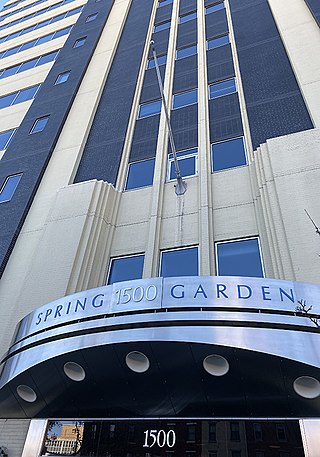
Nanoid robotics, or for short, nanorobotics or nanobotics, is an emerging technology field creating machines or robots whose components are at or near the scale of a nanometer. More specifically, nanorobotics refers to the nanotechnology engineering discipline of designing and building nanorobots with devices ranging in size from 0.1 to 10 micrometres and constructed of nanoscale or molecular components. The terms nanobot, nanoid, nanite, nanomachine and nanomite have also been used to describe such devices currently under research and development.
The impact factor (IF) or journal impact factor (JIF) of an academic journal is a scientometric index calculated by Clarivate that reflects the yearly mean number of citations of articles published in the last two years in a given journal, as indexed by Clarivate's Web of Science.

A nanostructure is a structure of intermediate size between microscopic and molecular structures. Nanostructural detail is microstructure at nanoscale.

Armand Paul Alivisatos is an American chemist and academic administrator who has served as the 14th president of the University of Chicago since September 2021. He is a pioneer in nanomaterials development and an authority on the fabrication of nanocrystals and their use in biomedical and renewable energy applications. He was ranked fifth among the world's top 100 chemists for the period 2000–2010 in the list released by Thomson Reuters.

Nature Materials is a monthly peer-reviewed scientific journal published by Nature Portfolio. It was launched in September 2002. Vincent Dusastre is the launching and current chief editor.

Analytical Chemistry is a biweekly peer-reviewed scientific journal published since 1929 by the American Chemical Society. Articles address general principles of chemical measurement science and novel analytical methodologies. Topics commonly include chemical reactions and selectivity, chemometrics and data processing, electrochemistry, elemental and molecular characterization, imaging, instrumentation, mass spectrometry, microscale and nanoscale systems, -omics, sensing, separations, spectroscopy, and surface analysis. It is abstracted and indexed in Chemical Abstracts Service, CAB International, EBSCOhost, ProQuest, PubMed, Scopus, and the Science Citation Index Expanded. According to the Journal Citation Reports, it has a 2020 impact factor of 6.986. The editor-in-chief is Jonathan V. Sweedler.

Charles M. Lieber is an American chemist, a pioneer in nanoscience and nanotechnology, and a convicted felon. In 2011, Lieber was named the leading chemist in the world for the decade 2000–2010 by Thomson Reuters, based on the impact of his scientific publications. He is known for his contributions to the synthesis, assembly and characterization of nanoscale materials and nanodevices, the application of nanoelectronic devices in biology, and as a mentor to numerous leaders in nanoscience.

The Journal of Electronic Materials is a monthly peer-reviewed scientific journal that publishes studies, research, developments, and applications of materials that produce electronics. The editor-in-chief is Shadi Shahedipour-Sandvik, SUNY Polytechnic Institute.The IEEE/TMS Journal of Electronic Materials (JEM) is jointly sponsored by the IEEE Electron Devices Society and The Minerals, Metals and Materials Society. It is published by Springer on behalf of IEEE and TMS.
Nanoelectronics refers to the use of nanotechnology in electronic components. The term covers a diverse set of devices and materials, with the common characteristic that they are so small that inter-atomic interactions and quantum mechanical properties need to be studied extensively. Some of these candidates include: hybrid molecular/semiconductor electronics, one-dimensional nanotubes/nanowires or advanced molecular electronics.
Journal Citation Reports (JCR) is an annual publication by Clarivate. It has been integrated with the Web of Science and is accessed from the Web of Science Core Collection. It provides information about academic journals in the natural and social sciences, including impact factors. The JCR was originally published as a part of the Science Citation Index. Currently, the JCR, as a distinct service, is based on citations compiled from the Science Citation Index Expanded and the Social Sciences Citation Index. As of the 2023 edition, journals from the Arts and Humanities Citation Index and the Emerging Sources Citation Index will also be included.

The nanoscopic scale usually refers to structures with a length scale applicable to nanotechnology, usually cited as 1–100 nanometers (nm). A nanometer is a billionth of a meter. The nanoscopic scale is a lower bound to the mesoscopic scale for most solids.
The Feynman Prize in Nanotechnology is an award given by the Foresight Institute for significant advances in nanotechnology. Two prizes are awarded annually, in the categories of experimental and theoretical work. There is also a separate challenge award for making a nanoscale robotic arm and 8-bit adder.

The Web of Science is a paid-access platform that provides access to multiple databases that provide reference and citation data from academic journals, conference proceedings, and other documents in various academic disciplines. It was originally produced by the Institute for Scientific Information. It is currently owned by Clarivate..

Christoph Gerber is a titular professor at the Department of Physics, University of Basel, Switzerland.

Acta Biomaterialia is a monthly peer-reviewed scientific journal published by Elsevier. It is published on behalf of Acta Materialia, Inc., and is sponsored by ASM International and The Minerals, Metals & Materials Society. The journal was established in January 2005. The editor-in-chief is W.R. Wagner. The journal covers research in biomaterials science, including the interrelationship of biomaterial structure and function from macroscale to nanoscale. Topical coverage includes biomedical and biocompatible materials.

Materials Horizons is a bimonthly peer-reviewed scientific journal that covers research across the breadth of materials science at the interface between chemistry, physics, biology and engineering. The current editor-in-chief is Martina Stenzel. The journal was established in 2014. A sister journal Nanoscale Horizons was launched in 2016.

Nanomedicine is a biweekly peer-reviewed medical journal covering research on medical nanoscale-structured material and devices, biotechnology devices and molecular machine systems, and nanorobotics applications in medicine. It was established in 2006 and is published by Future Medicine. The editors-in-chief are Kostas Kostarelos and Charles R. Martin.

Clarivate Plc is a British-American publicly traded analytics company that operates a collection of subscription-based services, in the areas of bibliometrics and scientometrics; business / market intelligence, and competitive profiling for pharmacy and biotech, patents, and regulatory compliance; trademark protection, and domain and brand protection. In the academy and the scientific community, Clarivate is known for being the company which calculates the impact factor, using data from its Web of Science product family, that also includes services/applications such as Publons, EndNote, EndNote Click, and ScholarOne. Its other product families are Cortellis, DRG, CPA Global, Derwent, MarkMonitor, CompuMark, and Darts-ip, and also the various ProQuest products and services.
Tapas Kumar Maji is a professor in the Chemistry and Physics of Materials Unit at Jawaharlal Nehru Centre for Advanced Scientific Research, Bengaluru with research interests in topics related to porous materials, nanoscale metal-organic frameworks and composites and functional gel materials. Maji obtained his MSc degree in inorganic chemistry from Burdwan University in 1997 and PhD degree from Indian Association for the Cultivation of Science in 2002. He did a post-doctoral fellowship at Kyoto University, Japan (2003–05).














